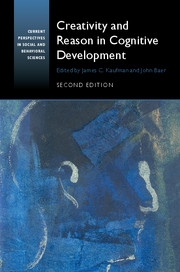Book contents
- Frontmatter
- Dedication
- Contents
- List of Contributors
- Acknowledgments
- 1 Creativity, Reason and Cognitive Development: Ten Years Later
- SECTION ONE CREATIVITY AND REASON IN CHILDHOOD AND THE SCHOOLS
- SECTION TWO CREATIVITY AND REASON IN COGNITION AND NEUROSCIENCE
- SECTION THREE CREATIVITY AND REASON: INTERACTIONS AND RELATED CONSTRUCTS
- 14 Opening up Creativity: The Lenses of Axis and Focus
- 15 Creativity and Reason: Friends or Foes?
- 16 Creative Self-Beliefs: Their Nature, Development, and Correlates
- 17 Individual Differences in Intelligence, Personality, and Creativity
- 18 An Update on “Does Culture Always Matter”: For Creativity, Yes, for Deductive Reasoning, No!
- Author Index
- Subject Index
- References
15 - Creativity and Reason: Friends or Foes?
from SECTION THREE - CREATIVITY AND REASON: INTERACTIONS AND RELATED CONSTRUCTS
Published online by Cambridge University Press: 05 February 2016
- Frontmatter
- Dedication
- Contents
- List of Contributors
- Acknowledgments
- 1 Creativity, Reason and Cognitive Development: Ten Years Later
- SECTION ONE CREATIVITY AND REASON IN CHILDHOOD AND THE SCHOOLS
- SECTION TWO CREATIVITY AND REASON IN COGNITION AND NEUROSCIENCE
- SECTION THREE CREATIVITY AND REASON: INTERACTIONS AND RELATED CONSTRUCTS
- 14 Opening up Creativity: The Lenses of Axis and Focus
- 15 Creativity and Reason: Friends or Foes?
- 16 Creative Self-Beliefs: Their Nature, Development, and Correlates
- 17 Individual Differences in Intelligence, Personality, and Creativity
- 18 An Update on “Does Culture Always Matter”: For Creativity, Yes, for Deductive Reasoning, No!
- Author Index
- Subject Index
- References
Summary
We here explore possible links between reasoning and creativity. Creativity has sometimes been described as a blind search with retention of fortuitous “good” ideas, as a “freewheeling” mental activity, as “thinking outside the box” and as the result of “primary processes” that are intuitive. Creativity is often contrasted with adaptive step-by-step processing, controlled thought, logic and prototypical “reasoning” behavior. However, is this dichotomy a reasonable picture of the way things work, or rather a caricature that hides some deep links between reasoning and creativity? First, the relationship between the development of logical thought and creative thinking in children is examined. Then connections between creativity and formal and postformal reasoning, in particular dialectical thinking, are studied. Finally, implications and conclusions are drawn.
In this chapter, we consider reasoning, in general, as the act of thinking based on inductive and deductive processes. It is often associated, more specifically, with the process of developing and supporting assertions, claims, proposals or conclusions from facts or premises, based on a set of arguments (Reber, 1995). Reasoning, in many cases, provides the basis for action or decisions. The development of reasoning is often viewed as an important educational goal.
Creativity, in contrast, can be defined as the capacity to produce novel, original work that fits with task constraints (Lubart, 1994). Work refers to all types of ideas and productions. This work must be novel in the sense that it goes beyond a replication or copy of that which exists. The extent to which the work produced is novel can vary from being original only for the person who completed the work (this is the notion of reinventing ideas known already in the larger social context) to being original for a limited social group, to being original for all of humanity. The second component in the definition concerns the fit with constraints. We distinguish creative ideas from bizarre ideas, which are also novel, because creative ideas take into account the parameters of a situation, the constraints. Novel productions that are in some way “useful”, or “worthwhile”, in a given context are, thus, creative.
In the following sections the links between reasoning and creativity are examined.
- Type
- Chapter
- Information
- Creativity and Reason in Cognitive Development , pp. 282 - 301Publisher: Cambridge University PressPrint publication year: 2016
References
- 1
- Cited by

